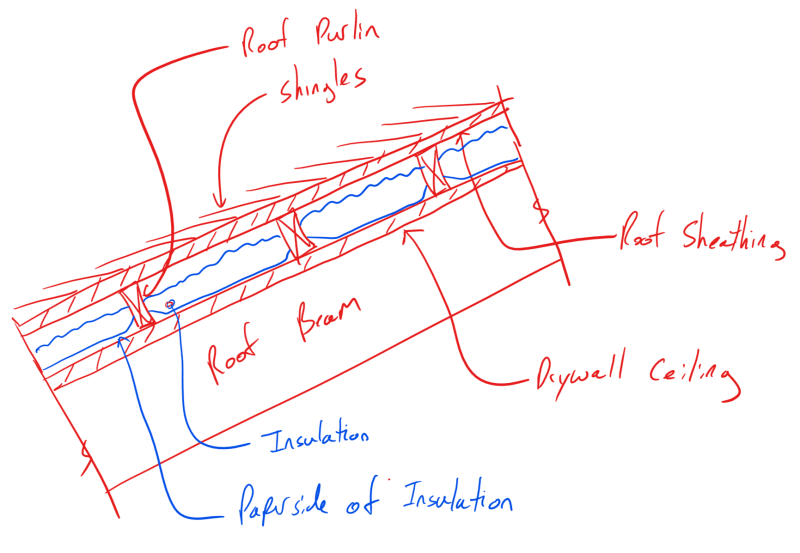RFreund
Structural
- Aug 14, 2010
- 1,880
I might be posting this in the wrong spot so feel free to redirect me.
I looked at a townhome/condo building where a resident was complaining of water dripping from their roof beams, ceiling and top of walls. The framing is similar to a pole barn where there are large roof beams with 2x4 or 2x6 purlins spanning over the roof beams. There is sheathing over the purlins and shingles on top of the sheathing. Gypsum board (aka gypboard, drywall) is fastened to the bottom side of the purlins. There is evidence of water dripping from the beams and water staining on the wall. They notice this happening in the spring and during the summer during hot days. I believe they have also had issues during the winter, but not as bad.
Here are my thoughts:
Warm moist air is condensing on the cool surfaces - ceiling and the beams. During the summer the outside air is humid and the inside air is cool and should be drier than the outside air. So this means that either:
[ol 1]
[li]There is warm moist air inside the house that is rising to the ceiling and condensing on the beams/ceiling or[/li]
[li]Outside air is getting inside through the roof[/li]
[/ol]
#1 Seems plausible because the return air is about 6' lower than the ceiling.
#2 Seems odd to me because I would think that since warm air rises, the air would be leaving the home. Not entering it. Also if this is the case I would think the air would be condensing on the exterior side of the gypboard (which it may be doing).
As for the solution - I'm not sure there is an 'easy' solution. There is really no way to vent the space between the drywall and sheathing due to the nature of the framing (2x4 @ 24" oc perpendicular to the beams). Therefore, I'm thinking removing the drywall and then using closed cell spray foam insulation. Then replace the drywall.
Any thoughts?
Thanks in advance!
EIT
I looked at a townhome/condo building where a resident was complaining of water dripping from their roof beams, ceiling and top of walls. The framing is similar to a pole barn where there are large roof beams with 2x4 or 2x6 purlins spanning over the roof beams. There is sheathing over the purlins and shingles on top of the sheathing. Gypsum board (aka gypboard, drywall) is fastened to the bottom side of the purlins. There is evidence of water dripping from the beams and water staining on the wall. They notice this happening in the spring and during the summer during hot days. I believe they have also had issues during the winter, but not as bad.
Here are my thoughts:
Warm moist air is condensing on the cool surfaces - ceiling and the beams. During the summer the outside air is humid and the inside air is cool and should be drier than the outside air. So this means that either:
[ol 1]
[li]There is warm moist air inside the house that is rising to the ceiling and condensing on the beams/ceiling or[/li]
[li]Outside air is getting inside through the roof[/li]
[/ol]
#1 Seems plausible because the return air is about 6' lower than the ceiling.
#2 Seems odd to me because I would think that since warm air rises, the air would be leaving the home. Not entering it. Also if this is the case I would think the air would be condensing on the exterior side of the gypboard (which it may be doing).
As for the solution - I'm not sure there is an 'easy' solution. There is really no way to vent the space between the drywall and sheathing due to the nature of the framing (2x4 @ 24" oc perpendicular to the beams). Therefore, I'm thinking removing the drywall and then using closed cell spray foam insulation. Then replace the drywall.
Any thoughts?
Thanks in advance!
EIT

